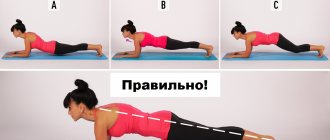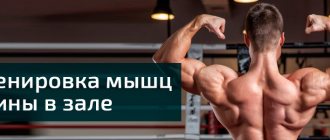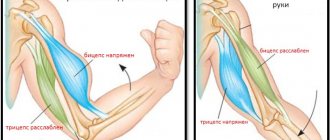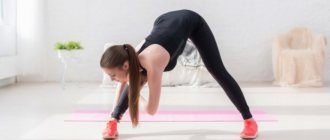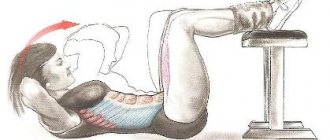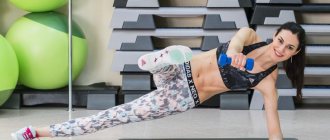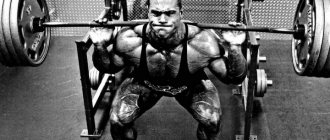Recently, static exercises have become increasingly popular. They are not as simple as they might seem at first glance, and they allow you to effectively work out your muscles. Static exercises involve tensing the muscles without moving. And one of the most popular among them is the plank, which is very popular in both fitness and yoga. The plank exercise is useful for men. Let's consider why it is good for the stronger sex, and how to perform it for maximum results.
Benefits of exercise
By doing the plank regularly, you can achieve:
- muscle strengthening
The plank gives a good load on the abdominal muscles, both oblique and rectus, and also makes the buttocks work.
- reducing pain in the spine and beautiful posture
The main advantage of this exercise is that it trains the spinal muscles without overstraining the spine itself, so you can do the plank even with minor problems with the spinal discs. The exercise also strengthens the abdomen, the muscles of which help support the back in the desired position.
- acceleration of metabolism
Speeding up your metabolism is especially important for overweight men, but it will also be useful for others.
- flexibility
While performing the plank, the posterior muscles of the legs and back are stretched.
Advantages and disadvantages
Beginning athletes often underestimate an exercise such as the plank. But if you do it regularly, then within a month the results will be noticeable. Those who go to yoga, fitness and even bodybuilding add this activity to their training schedule.
- eliminates pain in the spine;
- strengthens the muscles of the abdomen, shoulders, buttocks and lower back;
- increases flexibility;
- reduces stress;
- speeds up metabolism;
- reduces the risk of back injury.
It will be especially useful for men. Doing the plank exercise correctly is not difficult; after 3-4 weeks the athlete’s body will become more resilient. In a short period of time, a guy can dry out his body without much effort and achieve flexibility. The condition of joints and muscles, the musculoskeletal system will also improve.
- spinal injuries;
- inflammatory processes;
- hernias;
- increased blood pressure;
- chronic muscle pathologies;
- tendon or ligament injuries.
Rules for performing the classic plank
First you need to lie face down with your legs extended. Then you need to place your elbows exactly under your shoulders. The stance is correct if each arm forms a 90° angle and the forearms do not leave the floor. You can clasp your hands if this makes the stance more comfortable.
Then, transferring your support points to your toes and hands, you should lift your hips off the floor and rise until your back forms a straight line. For a beginner, it will be enough to hold out for half a minute in this position, but over time the duration needs to be increased.
Precautionary measures
It is recommended to start the program at difficulty level 1 and monitor the exercise technique daily to ensure proper execution.
Do the plank every day until the desired time is reached and you can move on to the next level of difficulty.
- If you experience discomfort or pain greater than 3 on a scale of 10 while standing, with 10 being the worst pain you've ever experienced, stop the exercise immediately.
- If you have back problems, be especially careful when doing plank crunches and variations that require you to lift your arm or leg.
It is very important that your back remains level and horizontal; to do this, always tense your abdominal muscles - this will protect your lower back. Avoid arching your back and lowering your buttocks toward the floor.
Always make sure your wrists or elbows are directly under your shoulders - this will take excess pressure off your shoulders. To make sure you perform correctly, have someone take a photo of you or consult with a trainer.
Remember to breathe evenly. Holding your breath makes the exercise more difficult and can cause your blood pressure to increase. Focus on breathing during the stance - this will help improve concentration and duration of the exercise.
Basic mistakes
Improper execution of the exercise is dangerous for sprains and even injuries, so it is important to avoid the following mistakes:
- Back arch. Its rounding also leads to the risk of injury.
- Incorrect pelvic position. It must be parallel to the floor, otherwise the lumbar region will be overloaded.
- Overstrain of the head, neck or shoulders. You need to make sure that they are located in the same plane.
- Bent legs. If the lower limbs are not straightened, then the effectiveness of the exercise decreases and the lower back becomes overstrained.
- The elbows (or wrists, depending on the type of plank) should be located under the shoulders.
Various types of planks
There are many variations of this exercise. Beginners should start with a classic stance, but as their muscles strengthen, they can try more advanced variations.
- On straight arms . The support is on the hands, and not on the elbows, unlike the classic version.
- With your hand raised . One of the arms is extended parallel to the floor. This type of plank improves your sense of balance. If you need to increase the load, you can take a dumbbell or other weighting material in your outstretched hand.
- With your leg raised. Reminiscent of the previous version, only one leg is extended. It is important to ensure that the knee is not bent. If you want to increase the load on the abs, the leg, on the contrary, needs to be bent and pulled towards the chest.
- With an arm and leg raised. A combination of the previous two exercises, the opposite limbs are raised. The buttocks and oblique abdominal muscles are especially worked out. You can increase the load by using dumbbells or kettlebells.
- Dynamic plank option. Starting position: stand with arms outstretched, feet together. Then, while inhaling, a jump is made, the feet should be shoulder-width apart. As you exhale, return to the original position.
- With a tourniquet. You will need two rubber bands connecting your ankles and wrists. Having stood in the classic version of the stance, you need to move the opposite arm and leg to the sides as much as possible, then slowly return to the starting position and repeat the same for the other pair.
- With a gymnastic ball. There are two options for the fitball plank. In the first case, it becomes a support for the forearms, in the second, the exercise is performed with straight arms, and the legs are placed on the apparatus. The stand can be alternated with push-ups.
What gives
One of the most popular exercises for developing abdominal muscles is the plank. What does the load give in general:
- The work involves not only the abdominal muscles, but also the legs, back, buttocks, and arms;
- not only the superficial part of the muscle corset works, but also the so-called “deep” muscles;
- The bar helps to recover from injuries when performing other exercises is impossible;
- Regular exercise helps develop endurance;
- using a plank, you can develop muscles before performing more traumatic movements;
- the muscles are put to work almost immediately after the start of the exercise, which allows them to be worked out as much as possible.
The exercise has become widespread due to a number of factors:
- it can be done at home, no equipment is required;
- The exercise time is relatively short, which is perfect for people with limited free time;
- there are many options for doing the plank, which will allow you to diversify your workout and change the emphasis of the load on other muscles;
- the load is accessible to almost everyone, it is increased by increasing the time the exercise is performed;
- There are no special contraindications.
When performing a plank, the following muscle groups are involved:
- Legs. The main emphasis is on the leg muscles; throughout the entire time they are under significant tension.
- Buttocks. At the beginning of the movement they contract and remain in this position throughout the entire time.
- Hands. They are also a fulcrum when doing planks.
- Breast. Thanks to the pectoral muscles, the correct position of the arms is ensured.
- Abdominal muscles, including the abs and obliques.
- Back. This group provides fixation of the spine.
The plank is used to a greater extent to work on the abdominal muscles, but this is not entirely the right approach. In essence, this is a general strengthening exercise aimed at working almost the entire body.
Losing weight in the abdomen and sides is only possible in combination with the rest of the body. The plank cannot be aimed at local fat burning.
The mechanism for reducing body fat is that it is necessary to force the body to use its own fat as energy. This is possible with a calorie deficit, which is achieved through belly fat loss exercises and diet.
The plank will help expend energy and trigger recovery processes, which will to some extent enhance weight loss.
For more effective weight loss, it needs to be combined with other movements - cardio and strength. Before you properly do the plank for weight loss at home, you need to create a clear training plan that will meet all the conditions necessary for losing weight.
Side plank
The side plank is a complicated version of the main exercise, and can only be performed with good physical preparation, but it also strengthens the muscles better.
The side plank also has several options.
- With support on the forearm. The fulcrum points are the edge of the foot and the forearm. The transition to this stance is carried out from a sitting position by lifting the pelvis until the body is extended in a straight line. If the exercise is difficult to perform, but a regular plank no longer loads the muscles enough, you can create an additional fulcrum by lowering your second leg to the floor.
- With a bench. The same side plank, but the legs are placed on a bench or other small elevation.
- At arm's length. The most common version of the side plank. The supporting arm is completely straight.
- With your leg raised. This stance can be performed either with an outstretched arm or with support on the forearm. The supporting leg remains in place, while the second one needs to be raised to shoulder level. In this case, the waist should be pushed up. If the exercise is performed correctly and the body does not fall back, the buttock muscles are perfectly worked.
- With leg lift (complicated). The difference from the option described above is that the leg is raised as high as possible and pulled forward. In addition to the buttocks, this stance also uses the inner thigh.
- With twisting. This exercise is dynamic. The starting position is a stand on an outstretched arm, with the second arm bent at the elbow and its palm covering the ear. After a minute has passed in this position, you need to touch the elbow of the other hand with the elbow of your bent arm. To do this, the body will have to be positioned parallel to the floor. Hold in this position for at least half a minute.
Known standards
Athletes have certain standards for men. They also touch the plank. The record for completing this exercise in time belongs to Chinese policeman Mao Weidong. He held the stand for 481 minutes without breaks. And among girls, Dana Glovaka is considered the record holder. She stood on her elbows for 4 hours and 19 minutes.
| Time | Level of training |
| 30 seconds | Newbie |
| 1 minute | Novice athlete |
| 1.5 min | Good preparation |
| 2 minutes | High level athlete |
| 5 minutes | Master |
Learning how to do a plank is not difficult, but you need to stick to the time intervals. Beginners only need to hold out for half a minute. The average is 60 seconds. An interval of 1.5 minutes is considered a good level. A 120 sec. - this is a high figure. Next, the athlete needs to increase the time spent in the stand to 3 minutes. If he can reach five, then he can be considered a master.
You need to work on your body every day. You can start with a kneeling position, which is easier to perform. It is better to repeat the exercise 3-4 times, trying to increase the time from 15 to 30 seconds. But it is not recommended to exceed this figure in the first two weeks, otherwise back injuries may occur.
Inverted plank
This exercise also applies to planks, although it is somewhat different from all previous options. To perform it, you first need to lie on your back, then rise up, resting your hands on the floor, until your arms are completely straightened. Palms face towards feet.
Alexander Shestov
TRX Certified Trainer
Ask a Question
You can make this plank more difficult by raising your legs. The knee is not bent. You can lift it as high as the stretch allows.
Does it help you lose weight?
The process of losing weight is a tandem of proper nutrition with restrictions, “movement” during the day and physical activity.
It makes no sense to do the plank from morning to evening, but at the same time not follow dietary restrictions the rest of the time and overeat on sweets and fatty foods, lying the rest of the time on the couch or sitting at the computer, the effect will be very weak.
It is correct to understand that the plank is a great tool that will make your body into the chiseled figure of your dreams under certain conditions.
Standing in a plank will help reduce body volume, but the process of losing weight is, first of all, dietary restrictions and the rejection of fatty and carbohydrate (sweets and flour) foods, and then an increase in physical activity, leading to greater calorie consumption and weight loss with the loss of fat. , not muscles, bones or water.
Yes, it will help you lose weight, especially if before losing weight your main ally was a sofa or chair.
Remember the secret combination that helps you lose weight in a minimum amount of time: dietary restrictions, movement during the day and exercise - the plank.
Although it does not burn as many calories as running, if you are in a calorie deficit with the addition of a plank, you get a good boost in a month.
It is important to remember that a large amount of muscle allows you to burn 17 times more calories than a person with more weight and fat.


